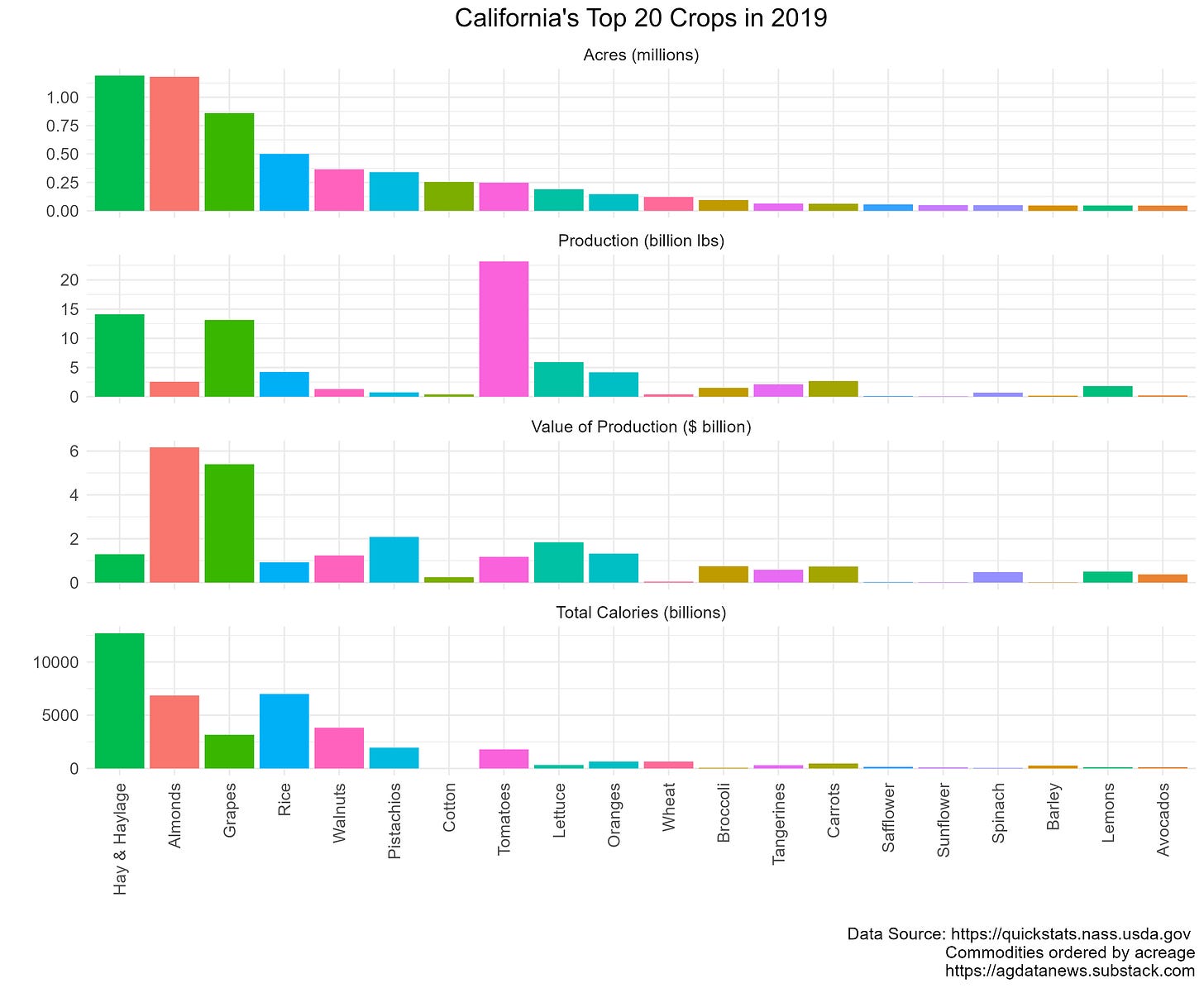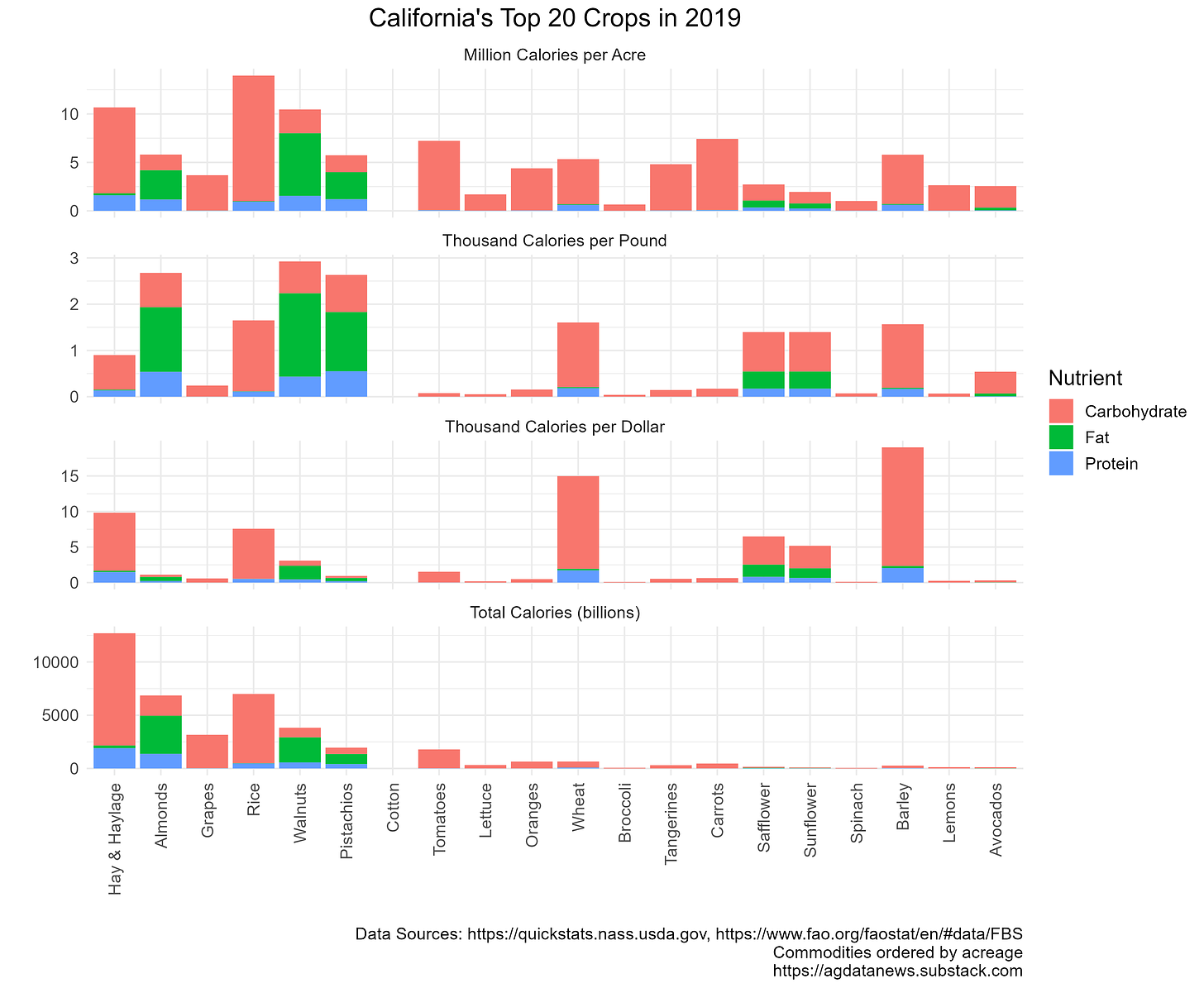
California farmers grow a lot of different crops. In each of the top agricultural states other than California, the top ten crops make up more than 98% of acreage. You have to sum up 43 different crops to accumulate 98% of California acres. The top 20 crops make up 85% of cropland in California, and the top 10 make up 75%.
Hay is by far the largest California crop by calories produced. In 2019, California farmers produced over 12 trillion calories of hay, more than the next two crops (rice and almonds) combined.
Humans cannot easily access the calories in hay. If we were to eat hay, it would pass right through us (and it would not be a pleasant eating experience, to say the least). Our stomachs do not contain the enzymes required to break down the cellulose in hay. Cattle can digest hay, but they require about 10 calories of food to produce a calorie of meat or milk. This means that only 10% of the calories in hay are accessible to humans.
Measured by acreage, the biggest crops in California are hay (including haylage) and almonds. Tomatoes are number one if measuring by weight. Almonds and grapes are the winners if measuring by dollar value.
On a per acre basis, rice produces the most calories at 14 million per acre. This means an acre produces enough rice to feed 19 people for a year at 2000 calories per day. Corn produces a similar number of calories per acre to rice, but it is not one of California's top 20 crops by acreage.
Other California crops that generate more than 5 million calories per acre include almonds, pistachios, walnuts, tomatoes, wheat, barley, carrots and hay. By contrast, spinach and broccoli produce less than a million calories per acre.
Among the top 20 crops, wheat and barley generate the most calories per dollar, followed by hay and rice. Wheat and barley produce more than 10 times the number of calories per dollar as broccoli and spinach.
Some crops generate high calories per acre because of high yield. Farmers produce a lot of calories per acre of tomatoes because each acre produces a lot of tomatoes. Other crops are very calorie dense. Farmers produce a lot of calories per acre of tree nuts because each pound of nuts contains a lot of calories. Typically, foods with high caloric density are high in fat. A pound of fat has more than twice the calories of a pound of carbohydrate or protein.
The plots below are the same as those above except color coded by nutrient. Tree nuts and oilseeds are the only crops in the top 20 with significant fat content. Most crops on this list have very little protein, which is one reason people eat meat and dairy products.
Feeding the world requires allocating a lot of land to high-calorie crops such as grains, oilseeds and tree nuts. But calories for people are only one attribute of food. We also grow significant amounts of hay, a product people don’t eat, because people like to eat products from animals that eat hay. We grow a lot of leafy greens, which are wasteful from the perspective of calories, because people like to eat them as part of salads and other dishes.
I made the figures in this article using this R code.
Addendum: I measure calories using data from FAOSTAT, but USDA's Food Data Central database produces similar numbers. A calorie is sometimes abbreviated as kcal and is the amount of energy required to raise the temperature of 1 kg of water by 1°C. I report data from 2019 so as to avoid Covid and the most recent drought. I use crop data from USDA NASS, which often reports somewhat different numbers to the county ag commissioners. For a comparison of the two, see our CA Crops data app. This post was inspired by Tamar Haspel’s writing and @WadeWarrens on Twitter.






So wasteful and environmentally ridiculous that gigantic herds of water using animals and their foraging needs are grown in California. We couldn’t fuck this up any better if it was our intent